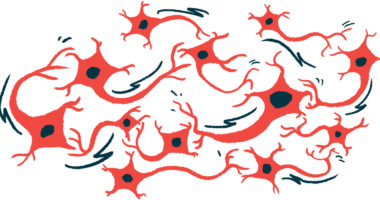Study sheds light on how SMN protein deficiency can cause SMA
Low levels affect neuromuscular function by preventing SNARE complex assembly

A group of proteins called the SNARE complex, which normally helps regulate how nerve cells receive chemical messages from other nerves, is disrupted in spinal muscular atrophy (SMA), according to a study with mouse models.
The findings suggest a deficiency in SMN, the protein missing in SMA, may impact neuromuscular function by preventing this complex’s assembly. Little has been known about how SMN1 gene mutations could trigger the rare disease.
Researchers also identified a protein that plays a key role in this disease-driving process and that could be a potential target for new SMA therapies.
The study, “A spinal muscular atrophy modifier implicates the SMN protein in SNARE complex assembly at neuromuscular synapses,” was published in Neuron.
SMA is caused by mutations in the gene SMN1, which provides instructions for making SMN. These mutations lead to substantially reduced SMN levels, which causes the progressive dysfunction and death of motor neurons, the nerve cells that control movement.
Because the lack of SMN protein causes motor neuron death, it’s well established that motor neurons need this protein to survive. The actual biological function of the SMN protein under normal circumstances remains poorly understood, however.
To find out more, a team led by U.S. researchers studied a mouse model of severe SMA caused by a specific mutation in the SMN1 protein. Without treatment, most of these mice showed profound motor impairment and didn’t live longer than a month, consistent with a model of severe SMA.
Some of these mice had much milder disease, however, with lifespans stretching up to nearly a year and markedly less motor impairment, even though tissue analyses showed very low SMN levels. The scientists reasoned there must be another genetic factor that led to less severe disease in these mice.
SMN protein levels and the SNARE complex
They conducted tests with selective breeding and DNA sequencing, zeroing in on a mutation in the gene that provides instructions for making a protein called HSPA8. The specific mutation was dubbed G470R, referring to the change in HSPA8 the mutation caused.
SMA mice harboring the G470R mutation in HSPA8 developed markedly less severe disease and had fewer problems with their motor neurons. They lived much longer, around 300 days, or 10 months, compared with the two-week survival of mice with typically severe SMA.
“We’ve never seen such a big increase in survival in these mice before, even when treated with nusinersen [Spinraza], a current SMA treatment,” Umrao Monani, PhD, a SMA researcher at Columbia University Vagelos College of Physicians and Surgeons and study lead author, said in a news release.
The results “unambiguously assigned a potent SMA-modifying property to the [HSPA8 protein with the G470R mutation],” the researchers wrote.
After confirming this mutation could affect disease severity in the mouse model, the scientists began to untangle the molecular mechanism causing this effect.
They started by examining the mutation’s effect on the SMN2 gene. Like SMN1, the SMN2 gene provides instructions for making SMN protein. Due to a sequence variation that affects how they are read, however, the SMN2 gene normally produces substantially less SMN protein, so its ability to compensate for mutated SMN1 is limited.
In SMA mice carrying the HSPA8 G470R mutation, SMN levels were elevated slightly, by about twofold over mice without the mutation, the researchers showed. This was due to biochemical changes that led to more protein production from SMN2. This modest increase in SMN levels was unlikely to fully account for the dramatic difference in survival and motor outcomes in the mice, data indicated.
The HSPA8 protein normally functions at synapses (the connections between nerve cells), where it helps regulate and stabilize the SNARE complex — a group of proteins that are critical for receiving chemical messages sent across the synapse by other nerve cells.
The effect of HSPA8 G470R mutation on the SNARE complex
In other experiments, the researchers showed the assembly of the SNARE complex is impaired in motor neurons that lack the SMN protein. The presence of HSPA8 with the G470R mutation led to the increased formation of this protein complex, both in diseased neurons and in neurons with normal SMN levels.
The G470R mutation caused the HSPA8 protein to interact more strongly with other synapse proteins, ultimately providing greater stability to the SNARE complex than the nonmutated version of the protein, the researchers showed.
“This suggested [HSPA8 protein with the G470R mutation] has a direct and potent effect of potentiating SNARE complex assembly,” they wrote.
The researchers noted the SMN protein has not previously been implicated in the functioning of the SNARE complex. These findings “cast new light on how low SMN triggers motor neuron dysfunction,” they wrote. “Arguably, the most noteworthy finding to have emerged from this work is that of disrupted SNARE complex assembly in SMA.”
Understanding these disease-driving molecular processes better could lead to new treatment strategies and improving synapse function by delivering the HSPA8 G470R mutation to patients may be an appealing one, they said.
“The simplest way would be to encapsulate the HSPA8 variant in a virus and deliver the gene therapy to patients, as we did with the mice. Another possibility is to use viruses or small molecules to convert normal Hspa8 into the variant,” Monani said.








